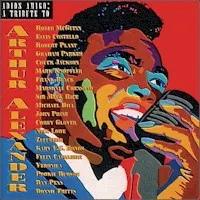Time: 68:18
Size: 156.4 MB
Styles: Saxophone jazz
Year: 2011
Art: Front
[4:23] 1. Pepper Returns
[4:57] 2. Broadway
[4:15] 3. You Go To My Head
[4:39] 4. Angel Wings
[4:35] 5. Funny Blues
[4:38] 6. Five More
[4:15] 7. Minority
[3:35] 8. Patricia
[4:13] 9. Mambo De La Pinta
[5:52] 10. Walkin' Out Blues
[3:18] 11. Straight Life
[5:42] 12. Yardbird Suite
[3:46] 13. Pepper Steak
[5:05] 14. You're Driving Me Crazy
[4:58] 15. Tenor Blooz
Despite a remarkably colorful and difficult life, Art Pepper was quite consistent in the recording studios; virtually every recording he made is well worth getting. In the 1950s he was one of the few altoists (along with Lee Konitz and Paul Desmond) that was able to develop his own sound despite the dominant influence of Charlie Parker. During his last years, Pepper seemed to put all of his life's experiences into his music and he played with startling emotional intensity.
After a brief stint with Gus Arnheim, Pepper played with mostly black groups on Central Avenue in Los Angeles. He spent a little time in the Benny Carter and Stan Kenton orchestras before serving time in the military (1944-1946). Some of Pepper's happiest days were during his years with Stan Kenton (1947-1952), although he became a heroin addict in that period. The 1950s found the altoist recording frequently both as a leader and a sideman, resulting in at least two classics (Plays Modern Jazz Classics and Meets the Rhythm Section), but he also spent two periods in jail due to drug offenses during 1953-1956. Pepper was in top form during his Contemporary recordings of 1957-1960, but the first half of his career ended abruptly with long prison sentences that dominated the 1960s. His occasional gigs between jail terms found him adopting a harder tone influenced by John Coltrane that disturbed some of his longtime followers. He recorded with Buddy Rich in 1968 before getting seriously ill and rehabilitating at Synanon (1969-1971). Art Pepper began his serious comeback in 1975 and the unthinkable happened. Under the guidance and inspiration of his wife Laurie, Pepper not only recovered his former form but topped himself with intense solos that were quite unique; he also enjoyed occasionally playing clarinet. His recordings for Contemporary and Galaxy rank with the greatest work of his career. Pepper's autobiography Straight Life (written with his wife) is a brutally honest book that details his sometimes horrifying life. When Art Pepper died at the age of 56, he had attained his goal of becoming the world's great altoist. ~bio by Scott Yanow
After a brief stint with Gus Arnheim, Pepper played with mostly black groups on Central Avenue in Los Angeles. He spent a little time in the Benny Carter and Stan Kenton orchestras before serving time in the military (1944-1946). Some of Pepper's happiest days were during his years with Stan Kenton (1947-1952), although he became a heroin addict in that period. The 1950s found the altoist recording frequently both as a leader and a sideman, resulting in at least two classics (Plays Modern Jazz Classics and Meets the Rhythm Section), but he also spent two periods in jail due to drug offenses during 1953-1956. Pepper was in top form during his Contemporary recordings of 1957-1960, but the first half of his career ended abruptly with long prison sentences that dominated the 1960s. His occasional gigs between jail terms found him adopting a harder tone influenced by John Coltrane that disturbed some of his longtime followers. He recorded with Buddy Rich in 1968 before getting seriously ill and rehabilitating at Synanon (1969-1971). Art Pepper began his serious comeback in 1975 and the unthinkable happened. Under the guidance and inspiration of his wife Laurie, Pepper not only recovered his former form but topped himself with intense solos that were quite unique; he also enjoyed occasionally playing clarinet. His recordings for Contemporary and Galaxy rank with the greatest work of his career. Pepper's autobiography Straight Life (written with his wife) is a brutally honest book that details his sometimes horrifying life. When Art Pepper died at the age of 56, he had attained his goal of becoming the world's great altoist. ~bio by Scott Yanow
The Capitol Vaults Jazz Series (Disc 1)




















